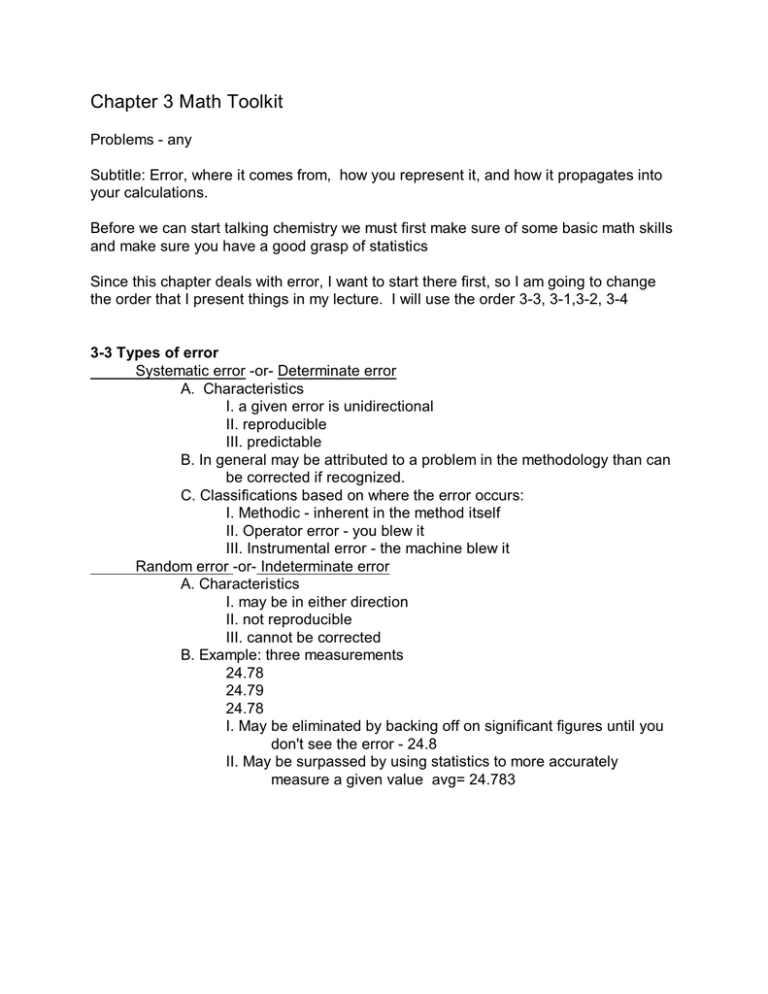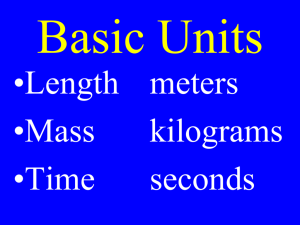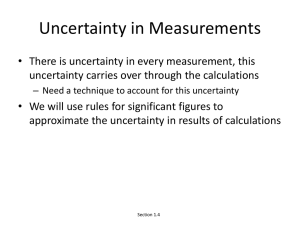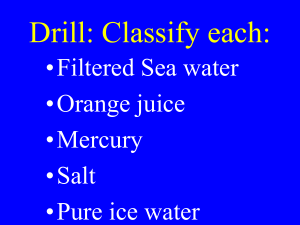Chapter 3 Math Toolkit
advertisement

Chapter 3 Math Toolkit Problems - any Subtitle: Error, where it comes from, how you represent it, and how it propagates into your calculations. Before we can start talking chemistry we must first make sure of some basic math skills and make sure you have a good grasp of statistics Since this chapter deals with error, I want to start there first, so I am going to change the order that I present things in my lecture. I will use the order 3-3, 3-1,3-2, 3-4 3-3 Types of error Systematic error -or- Determinate error A. Characteristics I. a given error is unidirectional II. reproducible III. predictable B. In general may be attributed to a problem in the methodology than can be corrected if recognized. C. Classifications based on where the error occurs: I. Methodic - inherent in the method itself II. Operator error - you blew it III. Instrumental error - the machine blew it Random error -or- Indeterminate error A. Characteristics I. may be in either direction II. not reproducible III. cannot be corrected B. Example: three measurements 24.78 24.79 24.78 I. May be eliminated by backing off on significant figures until you don't see the error - 24.8 II. May be surpassed by using statistics to more accurately measure a given value avg= 24.783 2 Precision and Accuracy Precision is a measure of how reproducible an experiment is Accuracy refers to how close a measured value is to the true value Want to have both!! If we have eliminated all systematic error, then we have achieved accuracy Unfortunately cannot eliminate indeterminate error, so there will always be some uncertainty in your results. Absolute and Relative Uncertainty - what is the +/- in our answer Expressions of precision of an experiment -or- the uncertainty in our result In Absolute error, the units of the margin of error are the same units as the measurement itself. Is 12.36 mL ± 0.2 mL. In Relative error we compare the size of the absolute error to the size of the measurement. Rel uncert.= absolute uncert/ magnitude of measurement In the above example .02/12.36 = 0.002. This is often converted to percent by multiplying by 100 (0.2%) -orparts per thousand (ppt) by multiplying by 1000 (2ppt) In the later sections I will refer to the absolute error in any measurement as e measurement, relative error in and measurement as %e measurement 3.1 Significant figures Significant figures refers to the number of digits written in a number need to convey the precision of the original number. The idea behind significant figures is that you write down all the digits in a number that are certain, and the first uncertain digit. Thus if your number is .1729873 with an uncertainty of .00016, the first three digits are certain, while the digit in the .0001 place is uncertain, so you should only write down the number .1730 (rounding up) to properly represent your number and its uncertainty with significant figures. 3 Let’s review the rules for writing with significant figures. Non zero’s 1. All nonzero digits count (123 -3 sig fig) Zeros 1. All zeros buried between non zeros count (12304 5 sig fig) 2. Left hand zeros do not count (.000234 3 sig fig) 3. Right hand zeros only count when a decimal is included in the number (10 - 1 sig fig, 10. 2 sig fig .0001230 4 sig fig) Sig fig and apparatus In most apparatus you will either read a decimal number directly or interpolate a value from some scale When you read form a scale you should only report one more digit that the hash marks on the scale. Thus a buret has marks every .1 mL so you can read 1 more digit, .01 mL When you read a number form a digital read out you should always assume that the last displayed number is the last significant digit (Watch it for a while it may drift up or down a digit) 3-2 Significant Figures in Arithmetic Let’s talk briefly about significant figures in your math. RULE 1. When you do you math, don’t round off to the proper number of significant figures until you reach your final answer What are the proper numbers of significant figures? It depends on the numbers and the type of calculation. Significant Figures in Addition&Subtraction The significant figures in an addition/subtraction depend on the number with the smallest number of significant digits after the decimal point. Round to the same decimal place as least determined number This is easy if the numbers are already in decimals 5.12 0.324 2.234567 4 7.678567 not rounded 7.68 rounded to match decimal of least determined number This can get trickier when you use exponents Take the case 1.632x105 4.107x103 2.984x106 All numbers have same number of significant figures Yes? But they are not equally well determined. You need to change them to a single exponent to see this. 1.632x105 0.04107x105 29.84x105 31.5131x105 not rounded 31.51x105 rounded to match decimal of least determined Naturally you round up if the last digits are greater that 5, and round down if the last set of digits is <5, but what if the last set of digits is 5 or 50 pr 500 etc, ie 5 exactly? ROUND TO AN EVEN NUMBER. Significant figures in Multiplication and division Round to the same number of digits as the number with the smallest number of significant digits 4.3179 X3.6 =15.5444 not rounded =16 rounded to 2 digits to match 3.6 Significant Figures in Logs and Antilogs (need in pH problems) The rule for rounding is that the number of significant figures in the mantissa (after the decimal place ) of the log term should be equal to the number of significant figures in the original number and vice versa Remember what logs and antilogs are: n=10a]logn=a If not, refer to appendix a. If you take the log of the number 339. you get 2.5302 on your calculator By the above rule we have three digits in the number so the log term should have 3 digits in the mantissa. Hence our answer should be 2.530 5 Let’s look at the reverse situation. Say I give you a pH of 7.01, what is the hydrogen ion concentration? To convert from pH to [H] you take the negative antilog or 10-7.01= 9.7724x10-8 but according to the above rule, there are only 2 numbers in the mantissa so our answer should only have two significant figures hence: 9.8x10-8. Note that the rule I have just given are approximations, there are places where they are not absolutely correct (see section 3-4 the real rules of significant figures). For the most part these rules work so let’s not worry about the finer details. 3-4 Propagation of Uncertainty The above rules for significant figures come from the different ways our relative and absolute error propagate through calculations. So let’s see how this really works, and what actual uncertainty should be. In any experiment there are lots of sources for random error. The balance can only weigh to so many digits, I can read the buret to so many digits, the volume in the volumetric flask only has so many digits. With any experiment you should be able to analyze these sources of error and determine the total uncertainty in your final answer. To do this you need to examine the math that goes into the answer, break it down into individual steps, and then analyze how the error propagates through each step. In propagation of error I am talking about how the errors inherent in several measurements are propagated through into the final result you obtain in an experiment. Thus we I will talk about eresult the absolute error in your final result, and e1, e2, ... As the absolute errors in several individual measurements. You will also see %eresult and %e1 as the respective relative errors. There are two simple rule in error propagation, one for calculation involving +/and a second for calculation involving × or ÷ In addition and subtraction eresult = sqrt(e12 + e22+...) Where e are the absolute errors in each measurement In multiplication and division %eresult = sqrt((%e1)2 + (%e2)2+...) 6 Where %e means the relative uncertainty. ( e1 /value1) In mixed operations the error is determined by working your way through an equation using the appropriate error propagation for each step in the calculation. Once you get through with these computation you now need to go back and evaluate the significant figures in your result. The real rule for significant figures Earlier in this chapter I gave you some rules for estimating the number of significant figures in a number that you calculated. After you have gone through the actual propagation of error analysis you know what the true uncertainty in you number is. The true rule of significant figures is that the first uncertain digit is the last significant digit The Book goes on to give rules for logs and exponentials, but let’s not worry about such complications. You know where they are in the book if you ever need them. Let’s try these rules in an example EXAMPLE Let's calculate the error in a titration experiment based on the error in our weighings and the error in reading our buret. (An error analysis like this is included in the write-up for several labs). We wish to assess the uncertainty in the calculation of the molarity of a solution of base used in the lab. To determine the molarity of the base we weigh out Potassium acid phthalate, MW 204.2 and titrate it against the base solution. The actual amount of KHP used titrated is: Your paper weighs .2306±.0001 gr.. Sample: 1.7202±.0001 gr. final weight: 1.7202-.2306 or 1.4896 grams . Eresult= sqrt((.0001)2 + (.0001)2 ) = square root(2x10-8)=.00014 For the buret reading we have the same kind of problem. Initial buret reading 0.02±.02 mls Final reading 37.43±.02 mls Total delivered volume 37.41±sqrt(.0004+.0004) =37.41±.028 7 Now in calculating the moles of sample present in this weight you have the equation: Moles KHP = moles base Moles KHP = grams KHP/ molecular weight KHP Moles base = Volume Base X Molarity of base Putting these together we have grams KHP/ molecular weight KHP = Volume Base X Molarity of base Where g=grams of sample, MW= Molecular weight of sample, V =volume of titrant, M=Molarity of solution. The actual molarity is: 1.4896/(204.2x.03741)=.1950 M What is the uncertainty in this number? First we need to know the % error in the individual numbers If the volume of titrant was 37.41 mls with an uncertainty in the measurement of .028 mls then the %uncertainty in this number is : .028/37.41 X100=.0748% The %uncertainty is the weight is .00014/1.4891 x100=0.0094% We will assume a 0 uncertainty in the molecular weight so we have %Eresult= sqrt(.07482 + .00942) = .0754% Report as .1950+/- .075% or +/- .00015 (absolute) 3-5 Introducing Spreadsheets & 3-6 Spreadsheet + Graph = Power Spreadsheets are a very powerful tool for doing lots of tedious calculations quickly and accurately. If you have used spreadsheets before, great. If you haven’t, read through this section, then go to a computer lab on campus and work through the examples in the text. Feel free to use spreadsheets for any take home calculations or labs in this class. Just to make sure you can use spreadsheets, the second lab has a spreadsheet component to it.









